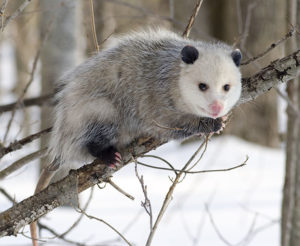by Kennedy Zittel, Asst. Naturalist
 Ever since I was little, I have always loved possums! Or, opossums… well we will discuss that later. There are even several photographs of me as a toddler chasing after an opossum in our forested backyard trying to befriend the cute creature. Perhaps unsurprisingly, I never did manage to befriend them. As I grew older and learned more about them, I have grown to love them even more, as they are so interesting!
Ever since I was little, I have always loved possums! Or, opossums… well we will discuss that later. There are even several photographs of me as a toddler chasing after an opossum in our forested backyard trying to befriend the cute creature. Perhaps unsurprisingly, I never did manage to befriend them. As I grew older and learned more about them, I have grown to love them even more, as they are so interesting!
Opossum or possum? Excellent question. Both terms are used when referring to the Virginia Opossum (native to Wisconsin). The word “opossum” comes from the Algonquian word “apasam” meaning “white animal.” Early settlers referred to the creatures as “opossum”… however, through a process called aphesis (the loss of a short unaccented vowel at the beginning of the word) the “O” was dropped giving way to the term “possum.” This is pretty confusing, especially given that possums are completely different animals than opossums. Possums are marsupial animals native to Australia, New Zealand, and China whereas the opossum is a marsupial animal native to America and southern Canada. Textbooks and scientific writings favor the usage of “opossum” whereas general speech has “possum” being more common. I grew up saying “possum” but now use the two interchangeably.
Regardless of what you call it, the Virginia Opossum (Didelphis virginiana) can be found throughout most of Wisconsin. They have adapted to live close to humans, and their adaptability has allowed them to survive for millions of years!
They are the United States only marsupial mammal, how neat! Baby opossums will stay in their mother’s pouch for around two months before they climb out onto their mother’s back for the cutest piggyback ride you will ever see! They have little hands that look similar to ours, they even have an opposable digit on their back feet similar to our thumbs called a hallux. Their fur-less hands are adapted to grab and hold onto things, perfect for helping them to climb. Speaking of climbing adaptations, they use their tails to help them climb and balance as well. They even use their tail to help carry bedding materials to their den!
Opossums are omnivores and are adept at scavenging for food… they will eat almost anything! They also have the most teeth out of any North American mammal, a whopping 50!
One thing that comes to people’s minds when they think of opossums is the saying “playing possum”… which is true! They really do fake their death when they are frightened. This behavior is involuntary, not a conscious choice made by the animal. They will fall onto their side, eyes open, drool, and emit a foul-smelling musk to deter predators. They can stay motionless like this for minutes to even hours until they start to wake up, beginning with a twitch of their ears.
Here at Woodland Dunes, we see opossums on our trail cameras throughout the preserve, both near the nature center and out in the State Natural Area. Whether or not you agree about them being the cutest animals ever, they are very important parts of our ecosystem. They are food for other animals, eat things we deem as pests, and clean up rotting foods and dead animals too. And they are our only native marsupial mammal, so that is pretty neat! Younger me would’ve been ecstatic to get to share all of this “possum” information with others, and hopefully it inspired you to see them as the unique and interesting creatures that they are too.
Photo from the University of Texas Biodiversity Center
